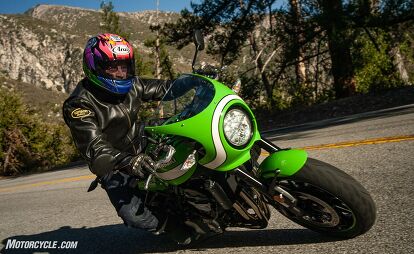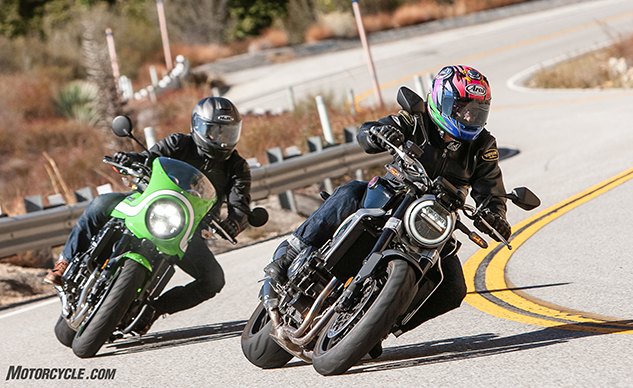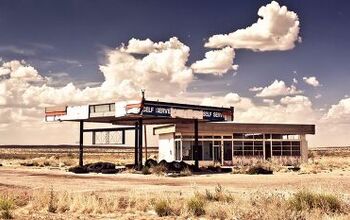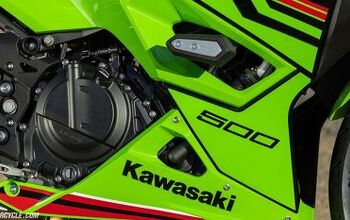Cafe Society: Honda CB1000R Neo Retro Cafe V Kawasaki Z900RS Cafe
We probably didn’t really need to compare the Honda CB1000R and Kawasaki Z900RS Cafe since they’re polarized enough in the looks department to make it appear that potential consumers will be drawn to one or the other – and their performance and mission statements both are close enough on paper to make them more or less interchangeable, aren’t they? I think we really just wanted an excuse to ride both of them again, they’re both such charismatic motorcycles. Everybody wants to hang out with them. What is a café racer? One that flits from Starbucks to Starbucks? Close enough for us.
First, let’s assess your needs: Where’s your cafe? One of our favorites is Crystal Lake Cafe, 5200 feet up in the San Gabriels, atop your classic winding mountain road. Mostly the pavement on the way up there is smooth, and the Kawasaki doesn’t mind it one bit, swooping gracefully from side to side and thanks to a pretty short trail figure, 89mm, steering lighter and quicker than you might expect from its ’80s looks. Once on its side, the Kawi feels super stable, though, and holds its trajectory easily and smoothly until the order is countermanded. Or steered. Its tires stick fine at footpeg-feeler scraping lean angles, and its nice suspension units erase ripples and small bumps. Ergonomically, the Cafe’s slightly lower handlebar than the vanilla Z900RS’s puts a smidge more weight on its front contact patch, and gives it a slightly more confident feel when attacking curves – but it’s ergos are still way closer to “standard” than they are to “sportbike.” Just right, really, for nearly all human body styles.
Another big difference with the Cafe is its throttle response: Where the RS could be snatchy, the RS Cafe’s power comes in way more smoothly from closed throttle. Kawasaki says the boys in Japan tell them nothing’s changed and part numbers are same-same, but obviously some retuning of the ECU has given the Cafe a much more refined and smooth throttle. What it feels like is really perfectly-tuned carburetion – a virgin vinyl record album as you drop needle gently onto disc on your expensive turntable… On this one, you don’t need to be dragging the rear brake when you want to get back on the gas leaned all the way over, just open it. There’s also KTRC traction control to keep you from spitting yourself into the weeds, but the Cafe doesn’t feel like it needs it on dry pavement on fresh rubber.
Brakes, dual 300mm discs, are plentiful, and on a bike this long and heavy, the rear’s really useful too, especially since both ends have ABS. Hack it into the tight corners, cheep cheep cheep…
All in all, though the Kawi Cafe is semi-styled after Ed Lawson’s racer, 1982 never had it nearly so good. I could ride this all day, but I won’t – because there’s a cheeseburger with my name on it up top at the cafe.
Hopping onto the Honda…
… you’re immediately informed that your knees are higher and the handlebar is an inch closer, at just about the same height as the Kawi’s. It’s the same semi-standard ergonomic layout, but the CB’s is just that much more compact and sporty. The Honda is 0.8-inch shorter of wheelbase (57.3 inches), 0.4-in higher of seat (32.7 inches) and 28 pounds lighter (467 lbs); 7mm more trail means it doesn’t steer quite as lightly as the Kawasaki, but the tiny bit of extra muscle required is payed back in increased road feel, which also comes back through the soles of your feet and the Honda’s knurled aluminum footpegs. The Kawi’s pegs are rubber. Speaking of rubber, the Kawasaki Cafe’s handlebar clamps are mounted in the stuff, where the Honda’s bar bolts up solidly and transmits more tactility but also more vibration at all rpm.
Are you getting the picture? As a sportbike the Honda’s a little sportier than the Kawasaki, with sterner suspension components at both ends to back it up. More sophisticated damping means the Honda is more confident at full lean through bumpy corners. If the Kawi feels a little analog, the Honda is fully digital: Its throttle response is a bit more abrupt, its reflexes are a bit quicker, it’s all-in-all a more lively, spry ride than the Kawasaki.
And even if the CB does suffer from a bit of a flat spot in the meat of its powerband, it still always feels more powerful everywhere than the Kawasaki, because it is, and because it’s 28 pounds lighter. But you have to work harder for it on the Honda, because its 68.5 lb-ft of torque doesn’t get there until 8300 rpm; the 50cc-smaller Kawasaki only makes 64.1 lb-ft, but it does it at just 6600 rpm. The Kawi makes it easier to be lazier if you want to be. Even its clutch pull is a tad lighter than the Honda’s, and its gearbox is 7.3% more lubricious.
On tight roads, there’s really not much in it. On faster ones where you can let the Honda unwind, its 121 horses at 9800 rpm will wave sayonara to the Kawi and its 96 hp at 8600. But that’s seldom the case on public roads.
But all-out sporting use isn’t either bike’s primary mission, though both are really good in that role. If that’s your priority, you want the Honda. It’s quicker, faster, better-suspended and sharper-handling. For a more relaxing, 80% pace up the mountain, possibly with passenger, it’s the green machine you want.
For rolling around town and on the freeway, the Kawasaki’s softer side comes to the fore. Compared to the regular ZR, Kawasaki stuffed a bit more foam into the seat, and when you lean slightly more forward to its lower grips, that foam provides a lovely nest for your huevos rancheros.
Again, Kawi suspension is a bit softer in both springs and damping. At higher speeds its old-school half-fairing does excellent work deflecting air smoothly around your torso, and its rubber bar mounts make it nearly vibration-free everywhere. Add all that up atop its long wheelbase, and you’re looking at a really smooth, comfortable Q-ship that once rolling, has very little respect for posted speed limits. It’s a shame they left off the cruise control, because you could go places on this bike.
And if you hadn’t just climbed off of the Kawasaki Cafe, you’d think Honda’s Neo Retro was a pretty dang comfortable corner booth, also. Its more compact cockpit might be snug for tall riders, but for most of us it’s really nice, with less reach to the grips than the Kawasaki, and just enough forward lean to make you not mind not having a fairing most of the time, up till about the “felony speeding” zone. The seat’s not as plush as the Kawi’s but it’s a good shape. While the CB’s suspension is sporty, it’s not overly so. Over broken-up pavement, in fact, its superior damping lets the Honda float through more smoothly than the Kawasaki.
To mask its midrange flat spot, Honda shortened final gearing 4% compared to the previous CB1000R, and you feel that in the form of increased vibration through the solid-mount grips and footpegs. Which are in fairness, only a little buzzy compared to the serenely smooth Kawasaki.
All in all, if the Honda’s not quite the freeway luge that the Kawasaki is, its lighter weight, smaller size and more aggro nature make it maybe a little more fun for shorter urban and suburban hops. In the end, these are both excellent machines for around-town trawling, it almost comes down to which one you like the looks of and how you wish to interact with the world?
Details…
When you get to the cafe, you’ll be looking for a place to park your helmet if you’re on the Honda, while you listen to your passenger complain about the back seat. Meanwhile, the Kawasaki has a genuine external helmet lock that takes the ignition key – how convenient – and a superior back seat.
As you steal glances through the window at your baby, you’ll appreciate its sweet green paint, cool wheels, neat front fender and shiny chrome exhaust pipes…
The Honda is definitely a looker too, but its discolored stainless pipes look like they should be behind a fairing, and its cheap and slightly ill-fitting front fender more deserves the British term: mudguard. On the other hand, that seamless fuel tank, that one-sided swingarm, those brushed aluminum bits… me likey. I think there’s an old carbon-fiber front fender in the garage rafters someplace, and pipe wrap is all the rage.
If you’re torn between these two, it’s all going to come down to how you perceive yourself and how you want the world to perceive you: Modern, hip and edgy, or wait, not really. My kid the millennial loved the CB1000R, but I think he likes the old-school Kawasaki even more. Sometimes the things I assume are just for us old guys, the kids love. Old Spice, for instance. You can just never tell.
Hip young cats and crusty old beardoes seem drawn to both bikes in equal measure, really, though the Kawi more often elicits glimmers of recognition and approval in the eyes of leathery guys on bicycles who might be homeless. The CB attracts a younger, aspirational crowd who’re pretty sure they’re looking at something they should recognize but aren’t sure and don’t want to ask.
There it is. In spite of its premium price, the Honda and its superior power and lower weight dominate the Objective cake. But the Kawasaki makes it up in our Subjective rankings, retro-rolling its way to an overall win by less than one percentage point! So close, and yet so far away. Garcon! Another cafe retro, please.
Honda CB1000R
+ Highs
- That seamless tank is sculpture
- Completely true to its CB heritage
- You’ll get to “customize” it a little
– Sighs
- Enginewise we’re a little underwhelmed
- Cruise control would’ve been nice
- Those discolored head pipes are gonna bug even those without OCD
Kawasaki Z900RS Cafe
+ Highs
- Carries official Ed Lawson Seal of Approval
- Supersmooth, comfortable cruiser and moreso the cruiser you smooth
- It’ll make you friends wherever you go whether you want them or not
– Sighs
- Lacking the last 18.2% of the suspension/handling chops of the Honda
- Could cause bottom of vintage Kawi market to drop completely out
- Kawasaki says they’re not making many at all
In Gear: John

Helmet: Arai Signet Q Bomb discontinued
- Jacket: Vanson AR3 $562.50
- Gloves: Dainese 4-Stroke Evo $219.95
- Pants: Reax 215 $199
Boots: Alpinestars Campeche Drystar $249.00
In Gear: Troy

Helmet: HJC RPHA 90 Tanisk $449.99-$454.49
- Jacket: Alpinestars Core Leather Jacket $589.95
- Gloves: Alpinestars SP-2 V2 Leather Glove $139.95
- Pants: Alpinestars Crank Denim Pants $249.95
Boots: Oscar by Alpinestars Rayburn Riding Shoe $249.95
Honda CB1000R vs Kawasaki Z900RS Cafe Scorecard | ||
|---|---|---|
Honda CB1000R | Kawasaki Z900RS | |
Price | 88.5% | 100% |
Weight | 100% | 94.4% |
lb/hp | 100% | 76.2% |
lb/lb-ft | 100% | 88.8% |
Total Objective Scores | 96.2% | 92.3% |
Engine | 87.5% | 91.9% |
Transmission/Clutch | 80.0% | 85.0% |
Handling | 87.5% | 81.3% |
Brakes | 90.0% | 90.0% |
Suspension | 87.5% | 85.0% |
Technologies | 82.5% | 80.0% |
Instruments | 85.0% | 86.3% |
Ergonomics/Comfort | 82.5% | 90.0% |
86.3% | 91.3% | |
Cool Factor | 91.3% | 92.5% |
Grin Factor | 85.0% | 92.5% |
John’s Subjective Scores | 86.3% | 89.6% |
Troy’s Subjective Scores | 85.8% | 86.7% |
Overall Score | 88.1% | 89.0% |
Specifications | 2018 Honda CB1000R | 2018 Kawasaki Z900RS Cafe |
|---|---|---|
| MSRP | $12,999 | $11,499 |
| Engine Type | Liquid-cooled inline four-cylinder, DOHC 4 valve per cylinder | Liquid-cooled four-cylinder DOHC four-stroke |
| Bore x Stroke | 75.0 x 56.5mm | 73.4 x 56.0 mm |
| Displacement | 998 cc | 948 cc |
| Compression ratio | 11.6:1 | 10.8:1 |
| Fuel System | PGM-FI fuel injection w/ 44mm throttle bodies (throttle by wire) | Fuel injection (ø36 x 4) |
| Max. power | 120.7 hp at 9800 rpm | 93.0 hp at 8600 rpm |
| Max. torque | 68.5 lb-ft. at 8600 rpm | 64.1 lb-ft. at 6600 rpm |
| Final Drive | Chain | Chain |
| Transmission | 6-speed | 6-speed |
| Clutch type (Primary) | Slip-assist clutch | Wet, multi-disc |
| Front Suspension | 43mm Showa Separate Function Front Fork Big Piston (SFF-BP); adjustable spring preload, compression damping and rebound damping, 4.7 in. travel | Telescopic fork (upside-down), 4.7 inches of travel, fully-adjustable |
| Rear Suspension | Showa monoshock; adjustable spring preload, rebound damping, 5.2 in. travel | Horizontal back-link swingarm, 5.5 inches of travel, preload and rebound adjustable |
| Front Brake | Two hydraulic calipers w/ 310mm floating discs; 2-channel ABS | Dual 300 mm disc |
| Rear Brake | Single hydraulic caliper w/ 256mm disc; 2-channel ABS | Single 250 mm disc |
| Front Tire | 120/70ZR17 | 120/70ZR17 |
| Rear Tire | 190/55 ZR17 | 180/55 ZR17 |
| Caster (Rake angle) | 24.7° | 25.0° |
| Trail | 3.8 inches | 3.5 inches |
| Overall length | 83.1 inches | 83.5 inches |
| Overall width | 31.1 inches | 34.1 inches |
| Overall height | 42.9 inches | 46.5 inches |
| Wheelbase | 58.1 inches | 57.3 inches |
| Road clearance | 5.3 inches | 5.3 inches |
| Seat height | 32.7 inches | 32.3 inches |
| Wet weight | 468 pounds | 496 pounds |
| Fuel tank capacity | 4.3 gallons | 4.5 gallons |
More by John Burns



















































































Comments
Join the conversation
The peasants are burning Paris to protest climate change taxes! European bureaucrats are a scourge!!! Burn baby burn!
Wow, reading the article and scrolling through all the postings last thing I would expect to find is a heated discussion on emissions - on a motorcycle website?!
Since everything that had to be said was said x10, I would prefer to discuss the bikes themselves. First, I don't own neither Kawasaki or Honda (did own few Transalps in the past but that's all the connection I have to Honda). If the point of these built was "retro", then Kawasaki is a clear winner. It was successful in channeling the connection to its roots in the new bike. You cannot mistake it for anything else than a Kawi. Love the ELR paint, not as cool as the ZRX1200 but definitely not a deal breaker.
Honda built another rip off bike, this time it looks like they put Ducati Streetfighter and the MV Brutale 1090 (B4) in the same design studio and had their stylists follow quest off these aforementioned beautiful models. When Honda named their bike Neo Retro Cafe, what Honda retro design element was the factory referring to? Perhaps the instrument cluster... uhhh no, that is a direct rip off the MV cluster but where MV has a large Sweeper needle tach, Honda cheaped out and made it all digital. I really like the radiator side panels treatment, maybe Honda was indeed paying homage to the MV Brutale 1090RR... Honda even has similar fueling issues as the Ducati SF and the MV B4.